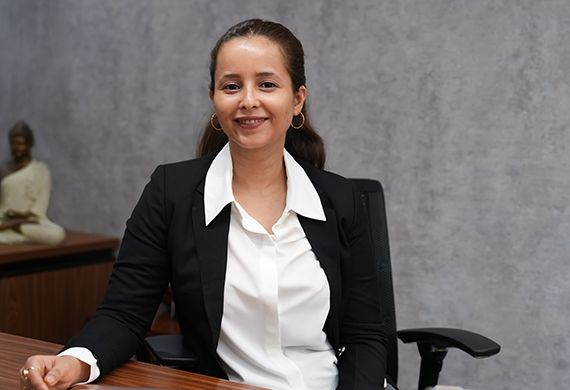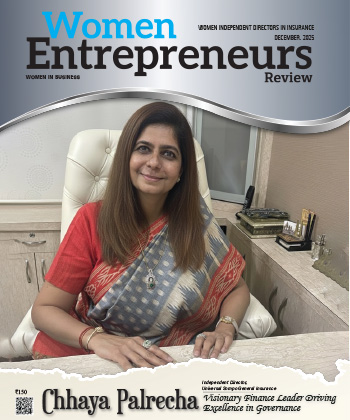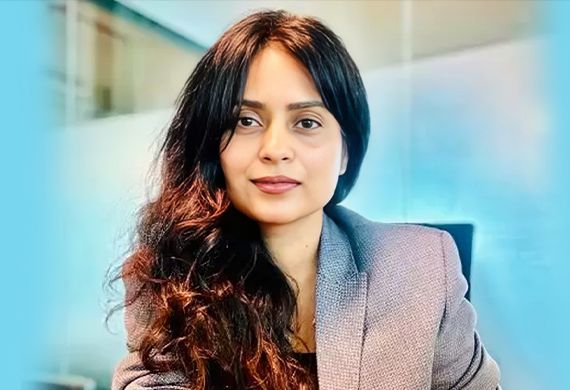
How Retail Reinvents People Strategy for Multi-Generational Women
By: Ira Kukrety, Head of Human Resource, Forest Essentials
With nearly 20 years in luxury retail and hospitality, Ira Kukrety serves as Chief Human Resources Officer, championing people-first strategies. An alumna of Delhi University, IIM Lucknow, and ISB Hyderabad, she blends behavioral insight with business acumen to drive inclusive, high-performance, and purpose-driven cultures.
In an insightful interaction with Women Entrepreneurs Review Magazine, Ira Kukrety shares her insights on how the retail sector is adapting its people strategies to meet evolving employee expectations, especially among women. She also talks about redefining leadership accountability and driving cultural change in founder-led, mid-sized companies.
How is the retail sector reshaping its people strategy in response to shifting employee expectations, particularly among women across multi-generational workforces?
Retail, like any industry, is shaped by shifts in the external environment, particularly evolving talent expectations and the growing need to manage generational diversity in the workplace.
People are the foundation of any business; they can either drive long-term success or undermine well-crafted strategies through ineffective execution.
In today’s evolving workplace, women seek more than just work-life balance; they seek true work-life integration. At the heart of this lies the recognition that women experience distinct challenges and aspirations at different life stages. Whether it's early-career growth, maternity, caregiving, or mid-career reinvention, the organisations need to acknowledge that no two journeys are alike.
By tuning into these varying needs, we aim to design personalized support structures rooted in empathy and flexibility, leveraging both in-house resources and external partnerships where needed. Active listening becomes crucial in this journey. Beyond formal reviews and policies, it is important to consistently track employee sentiment across both structured and informal platforms to truly understand the pulse of our workforce.
We move away from a one-size-fits-all mindset, offering customized initiatives, whether it's flexible schedules, holistic well-being sessions, or development opportunities designed to support each woman’s unique path.
To effectively manage these expectations, the first step is understanding them. Clearly defining these expectations is essential. It is also beneficial to segment employees into generational and gender cohorts to gain deeper insights into the needs and priorities of each group. Once this understanding is established, identifying actionable strategies becomes crucial.
A key component of this process is recognizing points of convergence, areas where expectations align, allowing businesses to craft a strategy that motivates and engages the workforce. This strategy must differentiate employee groups and approaches without creating rigid divisions. Successful implementation relies on equipping managers and HR teams with the necessary training to navigate these complexities effectively.
As HR shifts from policy enforcer to strategic architect, how are you redefining accountability and impact in leadership, especially in founder-led organizations navigating rapid growth?
As HR evolves into a strategic partner, it can seamlessly integrate people insights with business objectives, aligning them with the founder’s vision and expectations. This transformation shifts HR from being an enforcer to an enabler, driving rapid growth by fostering a more engaged, motivated, and strategically aligned workforce.
In founder-led organizations, vision is often deeply personal. HR plays a critical role in translating this vision into structured, scalable people strategies and decision-making.
HR leverages people analytics to assess leadership influence, tracking trends such as employee advocacy, decision-making effectiveness, and leadership resilience and impact in high-growth environments. These insights foster ongoing leadership refinement and fixing leadership accountability.
How do you balance tech-enabled efficiency with the emotional intelligence needed to nurture inclusive, high-touch employee experiences for diverse women professionals?
Human connection is at the heart of HR. As we streamline transactional, repetitive tasks that require minimal human judgment, we remain committed to fostering inclusive, high-touch employee experiences through meaningful interactions. This is achieved by equipping HR teams and line managers with the right training to engage effectively.
Our benefits policy framework allows flexibility on a case-by-case basis, ensuring support tailored to individual needs. We recognize that women navigate both work and home responsibilities equally, and acknowledging their unique challenges is essential for maintaining motivation and engagement in the workplace.
Every interaction should leave employees feeling heard, valued, and understood. Transparency is key here, not agreeing to everything, but working collaboratively to find fair and effective solutions that align with both business goals and employee expectations.
Balancing tech-enabled efficiency with emotional intelligence in talent engagement is crucial, especially when nurturing inclusive, high-touch experiences for diverse women professionals. Organizations are embracing a human-centered digital strategy that blends automation with personalized connection.
Through open communication channels, real-time feedback loops, and analytics to reduce biases. Leveraging technology to track data, create personalized career paths, and provide benefits. We use technology to enhance human interactions, not replace them.
How are you influencing cultural reinvention in mid-sized companies where legacy mindsets still exist while enabling female talent to challenge norms and redefine workplace success?
Creating a strong case for change is essential for every group within a legacy organization, including founders, tenured employees, and key stakeholders alike. The process begins by identifying the why behind the transformation; what factors are driving the need for change, what challenges must be addressed, and the tangible benefits that will follow.
Once the rationale is clear, the next step is to establish a pathway to change, defining the necessary actions and making the transition smoother and more achievable.
Women, particularly those in leadership roles, bring emotional intelligence that is invaluable in navigating organizational shifts. Their ability to engage in the emotional aspects of change positions them as key drivers in fostering transformation while addressing the challenges that come with it.
Conscious bias training, gender-equitable policies, and open conversations about systemic barriers are helping us rethink outdated practices. Empowering women by embracing non-traditional career paths, supporting them in work-life integration, and accommodating their unique challenges helps them redefine success, fostering innovation, collaboration, and emotionally intelligent organisations.
LAST WORD
Own your voice and believe in your strength. Always prepare your discussions from the standpoint of all important stakeholders, not just yours; it will open you up to different points of view and other corners of truth.
Remember that the strength of your leadership lies not in conforming, but in bringing your distinct perspective to the table. Influence is not about fitting into existing structures; it's about reshaping them. With conviction, clarity, and purpose. Stay rooted in your values, trust your expertise, and challenge outdated narratives with confidence.
Most Viewed
- 1 Women's Health Startup HerMD Closing Doors Amid Industry Challenges
- 2 5 Famous Women in Indian Armed Forces
- 3 Saudi Women No longer Require Male Permission for Clothing Choices, says Prince MbS
- 4 Kolkata Medtech Startup Innovodigm Raises Rs 5.5 Crore Seed Funding Led by IAN Group
- 5 Yamunanagar's Kashish Kalra Honoured after Securing 111th Rank in UPSC Civil Services Exam
- 6 Madurai Appoints Its First Woman Corporation Head
- 7 IAS Vijayalakshmi Bidari Appointed as the new Nagpur Divisional Commissioner
- 8 American Entrepreneur Lucy Guo Overtakes T Swift to become Youngest Female Billionaire
- 9 ICC Women's World Cup 2025 Trophy Showcased at Indore's Holkar Stadium
- 10 Aparna Saxena's Beauty Venture AntiNorm Launches in India
- 11 Vidya Nataraj Co-Founded BlueStone Jewellery & Lifestyle files IPO
- 12 5 Women Freedom Fighters of India
- 13 Dr. G Krishnapriya appointed as CEO for Trichy
- 14 M3M & Sirona Partner to Introduce Menstrual Hygiene Vending Machines in 15 Locations
- 15 Punjab Govt launches SHE Cohort 3.0 Supporting Tech-led Women Startups
- 16 Indian origin Lawyer, Sweena Pannu appointed as the US New Superior Court Judge
- 17 The Aurora Tech Award recognizes 4 Indian Women-led Startups
- 18 Kerala's Republic Day parade featured an all-female tableau
- 19 Manisha Kabbur Becomes Karnataka's First Woman International Karate Coach
- 20 Director K. S. Ravikumar's Daughter Maalica Ravikumar Launches Life Coaching Company 'Evergrowth Academy' for Women
- 21 Leezu's Raises Pre-Seed Funding to Accelerate Growth in Sexual Wellness Industry
- 22 Sattu: Super-easy summer drink for PCOS gut healing
- 23 Swathi Nelabhatla creates Sitha App, India's First Women-Exclusive Gig Platform
- 24 7 Timeless Female Kathak Dancers & their Iconic Legacies
- 25 Meet 7 Iconic Women Architects of Modern India & their Most Impactful Work
- 26 This Woman-led Insuretech Startup is Helping Bridge the Education Financing Gap in India
- 27 Women Leaders Share Lessons Learnt from India Women's WC Win
- 28 5 Enterprising Women Founders Powering Singapore's Tech & Innovation Landscape
- 29 4 Women. 4 Stories. One Vision for Smarter, Stronger Healthcare
- 30 Global Gender Gap Narrows to 68.8%, But Full Equality 123 Years Away: WEF Report 2025
- 31 Changemakers: 7 Women Entrepreneurs Taking the Make in India Movement Forward
- 32 Meet Lucy Guo, The Youngest Self-Made Female Billionaire Disrupting Tech
- 33 How Women are Driving India's Festive Online Shopping Surge






